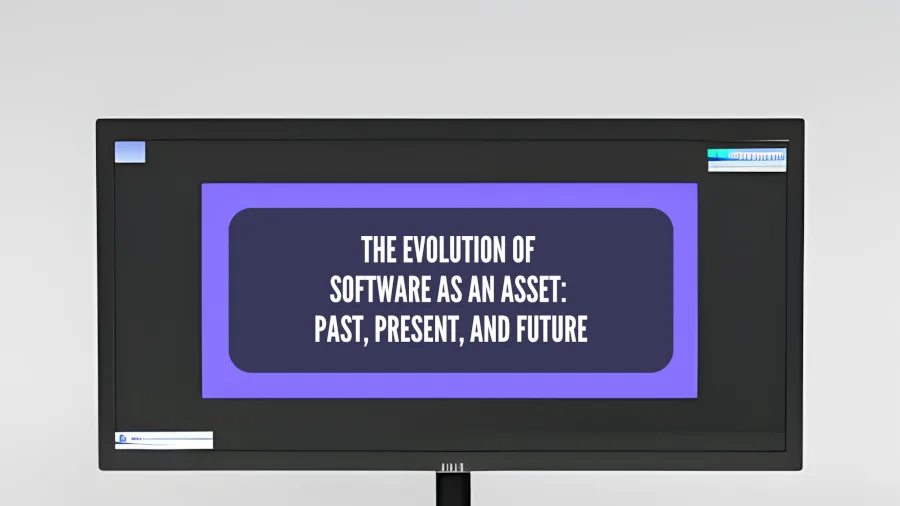In today’s rapidly advancing business landscape, software has become an indispensable asset, revolutionizing the way organizations operate and thrive. From the early days of basic programming to the sophisticated algorithms powering cutting-edge technologies, software has evolved from a mere tool to a strategic asset that can shape the success or failure of a business.
We hope to provide an in-depth exploration of the historical significance, current state, and future trends surrounding software as an asset. This article delves into the captivating journey of software’s evolution, shedding light on its past role, its current prominence, and the transformative shifts that will shape its future in the business world.
As businesses have grown increasingly reliant on technology, software has emerged as a vital component of their operations. It has transitioned from a supplemental tool to a strategic asset, capable of unlocking efficiencies, driving innovation, and propelling organizations towards success. Understanding the evolution of software as an asset is paramount for businesses seeking to navigate the ever-changing technological landscape and harness its transformative power.
The past significance of software as an asset witnessed the emergence of proprietary software, altering the course of businesses forever. Early on, software played a limited role, mainly serving as a tool to automate repetitive tasks. However, the proprietary software boom marked a turning point, propelling organizations towards a new era where software assets became key differentiators and competitive advantages.
Today, in the current state of software assets, we witness a landscape where software underpins almost every facet of business operations. It encompasses various types, from commercial off-the-shelf (COTS) software to custom-built solutions and open-source applications. Each type carries its own value proposition, presenting businesses with distinct opportunities and challenges in managing their software assets effectively.
Looking towards the future, several trends are poised to shape the role of software assets in the business world. The growing importance of data and analytics, the rise of cloud-based and hybrid software environments, the integration of automation and artificial intelligence (AI), and the advent of software asset monetization and marketplaces are among the transformative forces that will redefine the way businesses perceive and utilize software as an asset.
Join us as we delve into the fascinating world of software as an asset, where every line of code carries the potential to shape the future of business.
- The Past Significance of Software as an Asset
- The Current State of Software Assets
- Future Trends Shaping the Role of Software Assets
- Conclusion
The Past Significance of Software as an Asset
Software, in its earliest forms, was primarily developed to automate repetitive tasks and perform calculations. In the early days of computing, software was often created by the same individuals who built the hardware. However, its significance was limited as it was mostly seen as a tool rather than an asset with intrinsic value.
The advent of proprietary software marked a watershed moment for businesses. As software developers began to recognize the potential of their creations, they started commercializing their products. Proprietary software enabled organizations to gain a competitive edge by providing specialized functionality and exclusive access to valuable features. This shift elevated software from being a mere tool to a valuable asset that directly influenced business outcomes.
Over time, businesses realized the inherent value of software beyond its immediate functionality. Software assets were recognized as valuable intellectual property, protected by copyright and licensing agreements. This transition signified a fundamental shift in how organizations perceived and utilized software. Instead of treating software as a disposable tool, it became an asset with enduring worth, capable of delivering long-term strategic advantages.
Throughout history, certain software assets have stood out for their impact on businesses and society as a whole. Examples such as Microsoft’s Windows operating system, Adobe’s Creative Suite, and Oracle’s database software have not only transformed their respective industries but also generated substantial revenue streams for the companies that owned them. These iconic software assets illustrate the immense value that software can bring when recognized and leveraged as a strategic asset.

The Current State of Software Assets
In the present era, software has become an integral part of nearly every aspect of business operations. From enterprise resource planning (ERP) systems to customer relationship management (CRM) software, organizations rely on software assets to streamline processes, enhance productivity, and enable efficient decision-making. Software has become a critical factor in driving operational excellence and achieving business objectives.
Want proof of how far software is reaching into business operations? Here are just a sampling of the numerous examples of the available options:
Commercial off-the-shelf (COTS) software
COTS software refers to pre-packaged, commercially available software solutions developed by third-party vendors. These off-the-shelf applications provide businesses with ready-made functionalities and features, reducing the time and cost associated with custom software development. While COTS software offers convenience and cost-effectiveness, it may lack the tailored capabilities that organizations require.
Custom-built software
Custom-built software, developed specifically for the unique needs of a particular organization, provides a high degree of customization and flexibility. Such software assets can deliver a competitive advantage by aligning precisely with the organization’s business processes. However, custom development entails higher upfront costs and ongoing maintenance requirements.
Open-source software
Open-source software refers to software with source code that is freely available, allowing users to view, modify, and distribute it. Open-source software assets offer a collaborative approach to development and foster innovation within a community of contributors. They can provide cost savings, rapid customization, and a transparent development process. However, organizations must carefully manage open-source dependencies and ensure compliance with licensing requirements.
One of the key challenges in managing software assets lies in ensuring license compliance and addressing intellectual property considerations. As software assets are subject to licensing agreements, organizations must carefully navigate the complex landscape of software licenses to avoid legal repercussions. Non-compliance with licensing terms can result in costly penalties, damage to reputation, and potential legal disputes.
Furthermore, intellectual property protection is vital to safeguard software assets from unauthorized use or distribution. Organizations must understand the intellectual property rights associated with their software assets and take appropriate measures to protect them. This includes implementing robust security measures, monitoring for infringement, and safeguarding proprietary code or trade secrets.
Despite these challenges, effectively managing license compliance and intellectual property considerations presents opportunities for organizations to establish a strong foundation for their software assets. By implementing comprehensive policies and processes, organizations can ensure compliance, mitigate legal risks, and protect their valuable software assets. Some considerations include:
Software Asset Management (SAM) Practices
Successful management of software assets requires the adoption of robust Software Asset Management (SAM) practices. SAM encompasses various processes and strategies aimed at optimizing the acquisition, deployment, utilization, and retirement of software assets throughout their lifecycle.
SAM practices involve inventorying and tracking software assets, managing license agreements, and implementing processes for software procurement, deployment, and retirement. By maintaining a centralized and accurate inventory of software assets, organizations can gain better visibility into their usage, license entitlements, and compliance status.
SAM also enables organizations to control costs by identifying unused or underutilized software licenses, optimizing license allocations, and negotiating favorable terms with vendors. Additionally, effective SAM practices facilitate proactive license management, ensuring that organizations are aware of license renewal dates, compliance requirements, and potential risks.
Implementing SAM practices presents an opportunity for organizations to gain significant cost savings, minimize compliance risks, and optimize their software asset utilization. By streamlining processes, fostering accountability, and leveraging SAM tools and technologies, organizations can enhance their software asset management capabilities and maximize the value of their software investments.
The Rise of Software-as-a-Service (SaaS) Models
The proliferation of cloud computing and the rise of Software-as-a-Service (SaaS) models have introduced new opportunities and challenges in managing software assets. SaaS allows organizations to access software applications and services over the internet on a subscription basis, eliminating the need for extensive infrastructure investments and reducing the burden of software maintenance.
The adoption of SaaS offers several advantages, including scalability, cost-effectiveness, and seamless updates and maintenance performed by the service provider. Organizations can benefit from the flexibility of scaling their software usage based on their needs, reducing upfront costs, and relying on the expertise of SaaS providers to manage the underlying infrastructure.
However, the shift towards SaaS models also introduces challenges in terms of data security, vendor lock-in, and integration with existing systems. Organizations must carefully evaluate the security measures employed by SaaS providers to ensure the protection of their sensitive data. Vendor lock-in can be a concern, as organizations may face challenges in migrating data and applications to alternative solutions if needed. Additionally, integrating SaaS applications with existing systems and ensuring data interoperability can pose technical challenges.
By embracing SaaS models, organizations can capitalize on the benefits of flexibility, scalability, and cost-effectiveness. It is crucial for businesses to carefully evaluate SaaS providers, negotiate service-level agreements (SLAs), and establish robust data protection measures to maximize the value of SaaS offerings while mitigating associated risks.
In conclusion, managing software assets presents both challenges and opportunities for organizations. Ensuring license compliance, addressing intellectual property considerations, implementing effective SAM practices, and navigating the complexities of SaaS models are critical factors that organizations must address. By proactively managing software assets, organizations can optimize costs, mitigate legal and security risks, and leverage emerging models and technologies to drive business success in an increasingly digital world.

Future Trends Shaping the Role of Software Assets
As businesses collect vast amounts of data, software assets that enable effective data management, analysis, and insights are becoming critical. The integration of data analytics tools within software applications empowers organizations to extract valuable intelligence, make data-driven decisions, and gain a competitive edge. In the future, software assets that prioritize robust data capabilities will be highly sought after.
The adoption of cloud computing continues to accelerate, driving a shift towards cloud-based and hybrid software environments. Cloud-based software assets offer scalability, flexibility, and accessibility from anywhere, enabling seamless collaboration and remote work. Hybrid environments, combining on-premises and cloud-based solutions, provide organizations with the best of both worlds—control over sensitive data and the benefits of cloud scalability.
Automation and AI technologies are reshaping software assets, augmenting human capabilities, and driving efficiency gains. Intelligent automation, robotic process automation (RPA), and machine learning algorithms are increasingly embedded in software applications, streamlining workflows, reducing errors, and enhancing productivity. As AI continues to advance, software assets will become more intelligent, adaptive, and capable of autonomous decision-making.
In the future, software assets may not only serve internal organizational needs but also become sources of revenue. Software asset monetization involves licensing, selling, or renting software products to external users or other businesses. Moreover, the emergence of software marketplaces allows organizations to showcase and distribute their software assets to a broader audience, unlocking new revenue streams and fostering collaboration.
As software assets play a central role in storing and processing sensitive data, security and privacy concerns become paramount. The future of software assets will involve a heightened focus on cybersecurity measures, data encryption, compliance with privacy regulations, and robust access controls. Organizations must prioritize the protection of software assets and user data to maintain trust and avoid reputational damage.
Conclusion
In conclusion, the evolution of software as an asset has transformed the business landscape, from its early days as a tool to its current status as a strategic and valuable resource. Understanding the historical significance, current state, and future trends surrounding software assets is crucial for organizations seeking to leverage technology for competitive advantage.
As software continues to evolve, businesses must adapt to the changing landscape by effectively managing their software assets, embracing emerging trends, and leveraging the transformative power of data, analytics, cloud computing, automation, and AI. By recognizing software as a strategic asset, organizations can unlock innovation, drive operational excellence, and position themselves at the forefront of their industries.
In this fast-paced world of technological advancements, software assets have become the lifeblood of businesses, enabling them to thrive, compete, and shape the future. By harnessing the power of software assets and embracing their evolving nature, organizations can embark on a transformative journey towards success in the dynamic business world of tomorrow.
